Cook Like a Chef: 10 pantry essentials
Published 11:56 pm Tuesday, January 24, 2017

- (Thinkstock photo)
To cook more like a chef this year, rely on the power of your pantry.
It’s time to clear out and restock the staples at home with a variety of ingredients that will help you make better-tasting meals.
Trending
Chef Instructor Thor Erickson of the Cascade Culinary Institute at Central Oregon Community College in Bend is sharing his top 10 pantry items with us today.
“These are the foods that everyone who loves to cook should have on hand,” Erickson said.
A well-stocked pantry helps the home cook make quick meals with the simple addition of fresh or frozen produce and a protein.
First, spend an hour or so taking all of the food out of your kitchen cabinets and pantry shelves. Toss out anything with an expiration date that has come and gone. Resolve that this year, every time you buy a new food item for the pantry, you’ll mark the date on it, and buy a fresh one when you notice that it’s past its prime.
Here are Chef Erickson’s top 10 pantry picks to start the new year flavorfully.
1. Salt
Trending
“I put salt in position one because it’s one of the most important flavoring ingredients to have in a pantry. I prefer kosher salt because it’s not processed like granulated salt. It’s a pure form of salt, and it’s easy to pick up and measure with your fingers, and it looks like fallen snow on a dish,” Erickson said. He also likes sea salt, but noted that kosher salt has a better price point.
2. Dried herbs and spices
Erickson said that the life of a jar of dried spice or herb is one year. He cautions against buying the big value-size jars of herbs and spices.
“Are you really going to use that much? Remember that the room a big jar takes up is precious real estate in your pantry,” he said. Buy fresh bottles of the herbs and spices you tend to use a lot, and focus on the basics, like pepper.
“Buy peppercorns instead of the containers of ground black pepper because they have a longer shelf life in their whole form, and you can add whole peppercorns to a stock or brine. Freshly cracked pepper in a grinder or pepper mill is heavenly — that fresh scent of pepper — and it adds so much more to food than that “ground dirt that’s been hanging out in the container for who knows how long before you even buy it!” Erickson said with a chuckle.
3. Oils
Keep several kinds of oil on hand in your pantry: olive, canola, sesame.
As with all food products, buy good quality. “It’s always money well spent,” said Erickson.
“Don’t buy more oil than you’re going to use. Olive oil is universal to cook with and make vinaigrettes. Canola oil is lighter than olive oil, and it’s for high-heat cooking or a lighter vinaigrette. You can substitute grapeseed or avocado oil for high-heat cooking, if you’d like to try something different.
“When buying sesame oil, look for toasted, dark sesame oil, not the light kind. The dark sesame oil has the flavor. Sesame oil is not for cooking; it’s for marinades and finishing Asian foods. I prefer to buy a tin of sesame oil. It’ll last a couple of years in the pantry. The sesame oil sold in tiny bottles is not good, in my opinion,” said Erickson.
4. Vinegars
“I love vinegar. My pantry at home is absurd; I have all kinds of different vinegars, but the vinegars that are really good to have are: balsamic, white distilled vinegar — you can cook with it and clean with it — red wine vinegar or sherry vinegar, cider vinegar — I’m a big fan of the organic brand, Bragg’s — and unseasoned rice vinegar. Seasoned rice vinegar has sugar in it and is meant as a dressing for sushi rice,” Erickson said.
5. Pickled items: capers and olives
Always have a bottle of capers on hand. They’re the pickled flower buds of a plant called Capparis spinosa.
“You can use the juice (in the jar) for vinaigrettes, and use them whole in a pasta or chopped up and added to a sauce. It’s a great little burst of acid and salt that’s amazing,” said Erickson.
Kalamata olives are always in Erickson’s pantry and he thinks they should be in yours too.
“You can use kalamata olives for hors d’oeuvres with cheese and crackers, or chopped up into a stuffed chicken breast,” he said.
6. Condiments
You want to have soy sauce, chili paste and ketchup on hand in your pantry.
“A good quality, light soy sauce is want you want. Kikkoman brand is OK. As for chili paste, I could spend an hour talking about it. Either sriracha or Sambal, which is a little less refined, or gochujang, a fermented chili paste. You can use any of these on eggs, toss them with noodles, use them to dress up Asian stir fry recipes. I use them so many different ways, including in chicken brines,” Erickson said.
As for ketchup, Chef Erickson is not a fan of it as a condiment, but he said he is a fan of ketchup as an ingredient.
“For a lot of quick Asian recipes, adding a bit of ketchup adds a bit of umami flavor — an amazing sweet savoriness. I think of ketchup as a pickle. It’s basically a pureed relish sauce,” he said.
7. Canned Goods: tomatoes, coconut oil, beans
Erickson said stock your pantry with canned tomatoes from San Marzano, Italy, and have tomato paste on hand for a dash of umami taste without any sweetness. Have a can of coconut milk for inspiration to try Thai sauces and soups, and a variety of canned beans for an inexpensive source of protein to toss into soups, stews, tortilla wraps, or whatever strikes your fancy.
8. Baking items
“Toss out anything old. Keep all of your all-purpose flour, white and brown sugar, honey, baking soda, baking powder, cornstarch, vanilla in a cool, dark, dry spot. I always buy unbleached flour, and I’m a Bob’s Red Mill brand guy,” Erickson said.
9. Dry items: rice, pasta, rolled oats, split peas, quinoa
Keep an assortment of jasmine rice, dry pasta, rolled oats, split peas, lentils and quinoa on hand. Combine them with a freshly made sauce, or toss with an animal or vegetable protein and steamed or stir-fired vegetables for a meal in a bowl.
10. Dried fruit: raisins, apricots and prunes
“Chopped raisins and capers are one of the magical combinations in the world. It’s that sweet dried fruit combined with a very pronounced salty pickled flavor. Mix them and toss them with pasta, serve it with a soft cheese, or put them as a topping on a chicken breast with cream sauce.
“Dried apricots, cooked with rice, turns into a dish with a Middle Eastern touch. Prunes chopped up with roasted onions and stuffed inside a chicken breast are divine! A sauce made of a reduction of red wine vinegar or balsamic vinegar and pitted, chopped prunes with some onion or shallot is really nice, just add some butter,” Erickson said.
See his recipe below for that lovely sounding sauce. You’ll find out how your pantry redo, with great ingredients on hand, can serve you well all year, as you get better at cooking like a chef.
— Reporter: ahighberger@mac.com
Editor’s note: Cook Like a Chef is a feature designed to help you master cooking techniques that will give your homemade meals professional style and carefully crafted flavor. Each month, a chef instructor from Cascade Culinary Institute at Central Oregon Community College will walk us through a skill or recipe.








